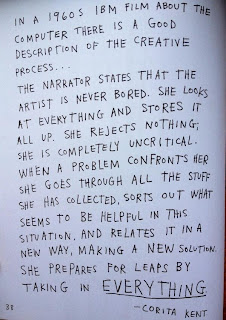Keri Smith is doing pretty well for herself at the moment.
You can’t go into a high-street bookshop without being tempted by Wreck this Journal
or its wiser and more costly cousin, How to be an Explorer of the World. I’m a
sucker for her work. I love it and I’m far from the only one; her appeal is
broad indeed. At school recently, I found myself chatting with three year nine
girls who were all meticulously following the brilliant and bonkers
instructions in one of Smith’s books and comparing the results. If you’re not
familiar with her stuff, she’ll fire you up with something like this:
Then suggest you get out of the house and do something like
this:
In a version of that spirit, I was riding my bike down
Chorlton Ees waiting for something interesting to happen and I reached an iron
bridge spanning the Mersey across which trams from Sale and Altrincham rumble their
way up into town. It happened that as I pulled up at the bridge for a rest, a
tram came hurtling past in a rush of air and noise, and I could watch it
through the chain link fencing only a few feet from me. The fencing there has
been detached from its rivets, probably by some kids looking for a thrill, so that
you can slip through onto the bridge and the tracks. There are two running
parallel to each other with a knee-high iron spine, maybe a couple of feet wide,
acting as a wall separating them.
I watched a couple more trams rush past,
trying to figure out whether it would be possible to lie on your back on that
divide, eyes tight shut, and feel the trams careering past only inches from
your face. The howl of noise and the smell of diesel and axle-grease; all of that
would really be something. The kind of kid with the guts to do it; interesting
too. Someone forced to do it against their will – even more compelling.
In a previous post here, I discussed a couple of books
exploring the source of good ideas. I’m not ashamed to say that there were
times, just after Poison Boy, when I wondered if I’d ever get a decent idea
again. The anatomy of the birth and gestation of an idea is a constant
source of wonder for me. How the hell does my mind work? Will it ever work
again? And if so, when? The short answer is, erm...dunno.
But that half an hour I spent with my face pressed against
the mesh of the fence watching trams is the beginning of something that’s worth
storing away; of that I’m sure. Perhaps it’ll have enough of a magnetic pull to
tug other thoughts into its sphere of influence and its gravity will grow.
Maybe it’ll become something more.
On the way home, I passed an advert for washing powder at a
bus stop, that claimed it could deal with “anything that life throws at you”,
and I misread it as “anything that throws life at you.” In a weird way, that’s
what Keri Smith’s work is about. Putting yourself in a situation where you get
a little bit of life thrown at you.
Maybe, if you do that often enough, something will stick.


